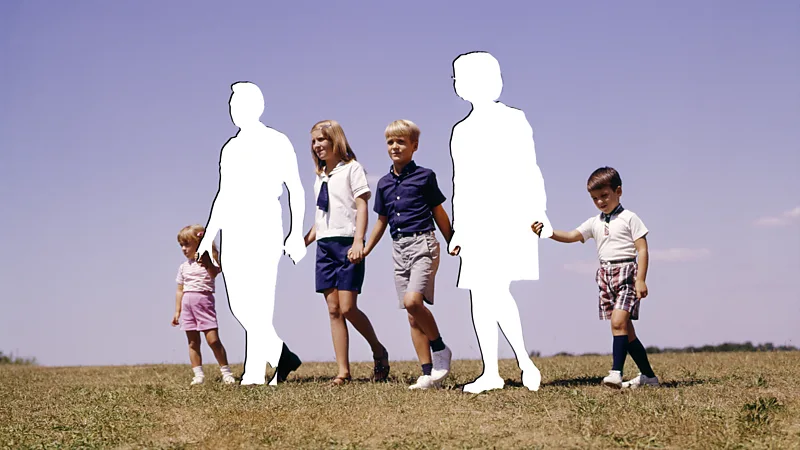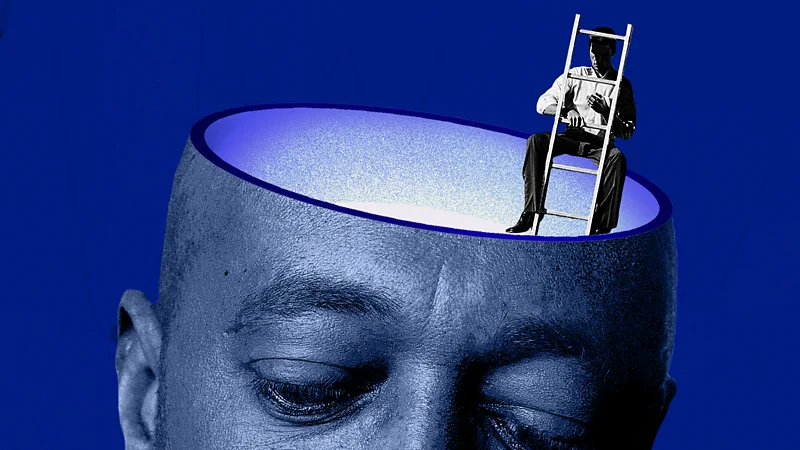'Biological reality': What genetics has taught us about race

As US President Donald Trump takes aim at the Smithsonian Institution for "anti-American ideology", Adam Rutherford examines what the science of genetics has taught us about race.
When scientists unveiled the first draft of the Human Genome Project 25 years ago, it seemed to deliver the final word on some antiquated myths about race. It provided definitive evidence that racial groupings have no biological basis. In fact, there is more genetic variation within racial groups than between them. Race, it showed, is a social construct.
But despite that fundamental finding, which has only been reinforced as work on human genomes has continued, race and ethnicity are still often deployed to categorise human populations as distinct biological groups. These are views that can be found circulating in the pseudoscience on social media, but they also still creep into scientific research and healthcare systems.
Comment & Analysis
Adam Rutherford is a lecturer in genetics at Univeristy College London in the UK, BBC Presenter and author of How to Argue with a Racist, which examines the history and science of notions of race. You can read more from him about how to debunk racist myths with science and facts here.
It is even more troubling when this thinking finds its way into the halls of government.
President Donald Trump and his administration have made no secret of his rejection of many aspects of the scientific worldview. Since returning to the White House, he has made sweeping cuts to science funding for biomedical and climate research, but in a recent Executive Order, Trump took aim at what most scientists now regard as biological reality.
Entitled "Restoring Truth and Sanity to American History", the Presidential order, signed by Trump, targeted an exhibition in the Smithsonian American Art Museum called "The Shape of Power: Stories of Race and American Sculpture".
The order is part of a broader attempt to shape American culture by eliminating "improper, divisive, or anti-American ideology" from the institute's museums. It states: "Museums in our Nation's capital should be places where individuals go to learn – not to be subjected to ideological indoctrination or divisive narratives that distort our shared history."
The exhibition itself is criticised in the text for promoting the idea that "race is not a biological reality but a social construct, stating 'race is a human invention'". The order offers the exhibition as an example of a "harmful and oppressive" shift in the narrative portraying American values.
This is the point when people like me, a geneticist who specialises in the history of race science, get a little bit vexed.

The issue here is that the sentence cited from the Smithsonian is 100% correct. This is neither controversial in science nor history.
Human variation is, of course, very real. People are different, and we can see those differences in skin pigmentation, in hair colour and texture and in other physical characteristics. These differences cluster in locations around the world: people from the same region on average look more similar to each other than to people from other areas – so far, so obvious.
In the 18th Century, these traits were the primary determinants for a new fashion for categorising humans in supposedly scientific terms. The Swedish botanist Karl Linnaeus is legitimately credited as the father of modern biology, as he gave us the classification system we still use today: genus and species. Every living thing is named according to this system, for example the bacteria Escherichia coli, or the lion, Panthera leo, or Gorilla gorilla, which probably doesn't need explaining.
We are Homo sapiens – wise people. But in his foundational work Systemae Naturae, Linnaeus introduced another tier of classification for us, designated primarily by that most visible of human traits: pigmentation. Linnaeus gave us four types of human, lumped together by continental landmasses: Asiaticus – people with "yellow skin", and straight black hair; Americanus – indigenous Americans, with "red skin" also with straight black hair; Africanus – "black skinned" people with tight curls in their hair; and Europeaus – "white skinned" with blue eyes.
These designations are clearly absurd – none of the colours are accurate, even if you took the obviously incorrect view that millions of people share the same skin tones even within those categories. But the roots of the race designations we still use today are visible in these labels. Some of these terms have fallen out of social acceptability and are considered racist. But we still use "black" and "white" as descriptors for millions of people, none of whom really have either black or white skin.
Even if this colour scheme were true, Linnaeus' original descriptions only began with physical traits. What he included in later editions of Systemae Naturae, which became the basis for scientific racism, were portrayals of behaviours. Asiaticus were described as "haughty, greedy and ruled by opinions" while Americanus were labelled "stubborn, zealous, regulated by customs". Africanus women were denoted as being "without shame" while both sexes were said to be "crafty, lazy, and governed by caprice". He described Europaeus as "gentle, acute, inventive, governed by laws".
By any definition in any age, these assertions are racist and entirely incorrect.
Of course, in examining history, we must be wary of judging people from the past by our own standards. But as the foundational text of modern biology, introducing a classification system for humans that is ludicrous, racist and most importantly, hierarchical, would leave an indelible mark on the centuries that followed.

Over the next 200 years, many men would seek to refine these categories with new metrics, including pseudoscientific interpretations of craniometry, or skull measurements. They never settled on a definitive answer about how many races there are – none of the characteristics that were being used are immutable, nor exclusive to the people to whom they were supposedly essential. We call this ideology "racial essentialism". But all of the many schemes put white Europeans as superior to all others.
It was biologist Charles Darwin who first began to unpick these ideas, recognising in his 1871 book the Descent of Man that there was much more continuity in traits between people that had been designated as discrete races. By the beginning of the 20th Century, molecular biology had entered the stage, and the era of genetics would dismantle the biological concept of race.
By the time we began to look at how genes are shared in families and populations, we saw that similarities do indeed cluster in groups, but these groupings do not align with the longstanding attempts to classify the races. The true metric of human difference is at a genetic level. In the 20th Century, when we began to unravel our genomes, and observe how people are similar and different in our DNA, we saw that the terms in use for several centuries bore little meaningful relation to the underlying genetics.
Even though only a tiny percentage of our DNA differs between individuals, the genome is so large and complex that there is great diversity. Geneticists are still working to unravel how this alters people's health, for example. But those genetic differences do not delineate along the lines of what we call race. They follow ancestral lines, can differ by geographic location and can be traced through historic migration patterns.
What we now know is that there is more genetic diversity in people of recent African descent than in the rest of the world put together. Take two people, for example from Ethiopia and Namibia, and they will be more different to each other at a genetic level than either one of them is to a white European, or indeed a Japanese person, an Inuit or an Indian. This includes the genes that are involved in pigmentation.
Yet, for historical reasons, we continue to refer to both Ethiopians and Namibians under the race definition of "black". Or take African Americans, people largely descended from enslaved Africans brought to the New World: sequencing the genomes of Black Americans reveals echoes of the history of transatlantic slavery. They not only mixed genetic ancestry from the handful of West African countries from which their ancestors were taken, but also significant amounts of White European DNA. This reflects the fact that slave owners had sexual relationships – many of which would not have been consensual – with enslaved people.
Therefore, the simple categorisation of descendants of the enslaved as "black" similarly does not make biological sense. They are genetically diverse in themselves and different from the African ancestors from which they are descended. To lump them together makes no scientific sense.
So it is by consensus, usage and history that we continue to use the term "black". This is what we mean by a social construct. The concept of race has little utility as a biological taxonomy. But it is enormously important socially and culturally. Social constructs are how the world works: money and time are both socially constructed too. The value of a pound or dollar is applied by agreement against goods and services. Time passes unerringly, but hours and minutes are entirely arbitrary units.
So, while race is not biologically meaningful, it has biologically meaningful consequences. The impact of most diseases correlates with poverty. As people of ethnic minority ancestry tend to be in lower tiers of socio-economic status, diseases tend to affect them more severely. This is true across the board, but was exposed early on in the pandemic. Black, South Asian and in America Hispanic people were disproportionately infected with and died of Covid-19.
The media immediately began to search for a reason that reified a biological version of race, sometimes focusing on vitamin D metabolism, which is connected with melanin production, and has effects on viral infections. Some studies showed that lower levels of vitamin D did associate with susceptibility to covid infection among black people. But this is a correlation not a cause.
Underlying any slight differences in biology are much more potent causes: while so many of us were locked down, frontline NHS workers, people cleaning up our rubbish and driving our buses all were more likely to be from ethnic minorities. They simply had a higher risk of being exposed and so infected with the virus. Combine that with the fact that minority groups are more likely to live in multigenerational, dense urban housing, and the supposedly biological susceptibility fades.
This is why genetics has played such an important role in the dismantling of a scientific justification of race and understanding racism itself. And it's why the latest statement from Trump's White House is troubling many in the scientific community.
Trump frequently speaks about aspects of genetics to make political points. One view that he has expressed repeatedly is that some people, and predictably himself, are genetically superior. "You have good genes, you know that, right?" he said in September 2020 to a rally in Minnesota – a state that is more than 80% white. "You have good genes. A lot of it is about the genes, isn't it, don't you believe? You have good genes in Minnesota."
Similarly, in the successful 2024 campaign, he denounced immigrants as having "bad genes". It's hard for someone who studies genes – and the strange and sometimes troubling history of genetics – to understand even what might constitute a "bad" or "good" gene.
Ours may be a pernicious history, but the trajectory of genetics has been one that tends towards progress, and equity for all, as enshrined in the Declaration of Independence.
--
Source: BBC























:max_bytes(150000):strip_icc():format(webp)/Health-GettyImages-ToothpasteOnAcne-4ea4cfedb2224b0fb601e61b59913d06.jpg)


































